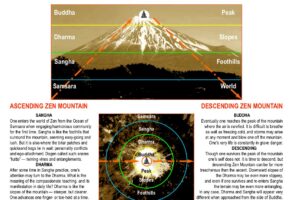
“So, to dream of a bright future does not mean turning away from the dismal present. It is where we are, where we sleep, live and die, and where we are to do the work. I hope that your practice of Zen will help you in this regard.
At year’s end it is tempting to fall into the clichés of reviewing transition points of the past year, and projecting hopeful visions of the coming year. It is also traditional to accentuate the positive, in assessing events in the context of a progressive model of history. But I would beg your indulgence to take a different tack, one that directs our attention to our personal practice, in the midst of our social milieu.
After the Rohatsu retreat in December, and remembering the basic teachings of Shakyamuni Buddha around those events, I feel it important to go to a dimension explored in the story of the Buddha, as well as others in the lineage, and which should be an aspect of our Zen practice. We might call it the Twilight Zone of Zen. Or a perhaps less contemporary analogy, Through the Looking Glass.
This will take us on a bit of a deep dive on the dark side. In Buddhism, the “Six Realms” include the upper realms of Tusita heaven; the Asuras, Titans, or angry gods; the realm of human beings; and the lower realms of animals and insects; hungry ghosts; and the denizens of Avici hell, unrelenting suffering. Hells, as well as heavens, are regarded as self-created, in Buddhism. Reality is neutral.
It is natural that we would prefer to look at the bright side, when approaching Zen practice in the context of the chaotic culture of modern times. But “In the light there is darkness, but do not take it as darkness; in the dark there is light, but do not see it as light” according to our Chinese Ancestors. We don’t find the bright side by ignoring the dark side. Instead, we are encouraged to confront our demons.
This premise is not exclusively Buddhist, of course. Each year during the holiday season we are treated to Christian-oriented homilies ranging from archival film of the original “Scrooge” by Charles Dickens to the more contemporary “Scrooged,” starring the inimitable Bill Murray. There is something comforting about these tragedies-turned-comedies-turned-epiphanies, as they all predictably achieve resolution, in the span of an hour-and-a-half, of some of the most stubborn and recalcitrant anxieties and fears we all feel. Would that real life were so simple.
In the earlier black-and-white film, the ghost of Jacob Marley asks Scrooge, “Why do you doubt your senses?” Scrooge scoffs that “…a little thing affects them. A slight disorder of the stomach makes them cheat. You may be an undigested bit of beef, a blot of mustard, a crumb of cheese, a fragment of an underdone potato. There’s more gravy than grave about you, whatever you are!” (Wikipedia)
Which bravado on Scrooge’s part is immediately demolished by Marley’s knee-buckling scream. While this exchange may represent a contemporaneous interpretation of dreams—or more specifically, nightmares—it also reflects our entirely human tendency to explain the unexplainable in sensible, physical terms. To “explain away” an otherwise unacceptable, frightening reality, a tendency that may explain the underlying motive, and provenance, of all religious belief.
This arcane interpretation of the cause of nightmares apparently still holds some sway today, if Wikipedia is to be believed:
Nightmares can have physical causes such as sleeping in an uncomfortable position or having a fever, or psychological causes such as stress or anxiety. Eating before going to sleep, which triggers an increase in the body’s metabolism and brain activity, is a potential stimulus for nightmares.
The popular online consensus dictionary also reminds us that: “…psychological nomenclature differentiates between nightmares and bad dreams, specifically, people remain asleep during bad dreams whereas nightmares awaken individuals.” It also differentiates nightmares from night terrors, which presumably stem from nightmares, but represent even more extreme cases of anxiety.
The reality of our self-created memes of paradise versus purgatory and perdition is not the issue in Zen; Zen questions the very reality of our so-called reality. There are many catchphrases in the history of Zen that point to this, such as “…like a dream, like a fantasy…” as attributed to Buddha’s own take on reality. The world of sleeping and dreaming is accorded a parallel reality, if not to the extent of the Dreamtime of the Australian aborigines.
Suffice it to say that in Zen, we exercise the same skeptical discernment in regard to our dreams, and their meaning, as we do to our daily lives. Someone said that Zen practice constitutes a pursuit of the understanding of meaning; we do not presuppose that we already know the meaning, either of dreams or daily life.
It sometimes seems that the relationship of dreaming to the world at large is shared by large contingents of the populace, especially in “interesting times,” such as we are having now. As the poet prophet Bob Dylan reported, “Everybody’s having them dreams” (Talkin’ World War III Blues).
The relationship of dreaming to life and death is a time-honored concern, touched on by the Bard of Avon in the famous soliloquy of Hamlet: “To die, to sleep—to sleep, perchance to dream—ay, there’s the rub, for in this sleep of death what dreams may come…” The anticipation and fear of the afterlife, perhaps foretold in dreams, or in the dreamlike states preceding death, as in the story of the “Bhiksu in the Fourth Dhyana” (Shobogenzo; Shizen-Biku; N&C).
Reading this fascicle will give you a broader and deeper insight into Master Dogen’s viewpoint on the folly of interpreting our experience with too high a regard for the state of our own understanding of Buddhism, and its relevance to our life and death. Briefly, from Nishijima and Cross’s introduction to the text:
[The title] refers to a monk who mistakenly thought that his own state was the state of the arhat, a Buddhist practitioner who has reached the fourth and ultimate stage of practice.
The story goes that when he was dying, the monk saw an apparition, an experience that is not associated with being in the fourth dhyana, and so lost faith in Buddha’s teaching and fell into one of the hells. This is a cautionary tale, admonishing us to avoid any conceit as to our own grasp of buddhadharma, and the high stakes of making such a mistake.
For my own part, this attachment to whatever stage of enlightenment one may wish to enjoy, or to hope to enjoy, has little or nothing to do with being reborn, whether into heaven, hell, purgatory, or into this same world. As I get it, the only preference one would harbor, regarding such an event, would be based on a conception—necessarily limited or erroneous, being biased and based on attachment to outcomes—of what rebirth into one or another realm would be like. It seems a moot issue, in that the very preference would distort the outcome.
But in Zen, confusion about such matters apparently comes with the territory of being a sentient being. Even Buddha was “assailed by the hordes of Mara,” according to tradition, the night of his profound insight. The visions consisted of horrific “demons,” seductive “daughters,” and all other such horrors as may be imagined, whether conjured from Siddhartha’s psyche, or from Mara, as the original source. The final temptation is said to be that the young prince was elevated to the level of a god, at which point he touched the earth, signifying his embrace of the ordinariness of his place in the world.

Other references that stand out in my admittedly superficial reading of the canon and commentaries of Zen Buddhism, include Carl Bielefeldt’s pointing out that in Master Dogen’s first written instructions (Fukanzazengi) for his students after returning from China, he chose not to include a line from the Chinese source, which read something like: “When the Path grows higher, demons flourish.” Bielefeldt opines that Dogen wanted to accentuate the positive, if not altogether eliminating the negative, in transmitting essentials of Ch’an zazen to his Japanese students.
Other comments, in passing, hover around the ambiguous nature of dreaming versus waking states in Zen, such as Master Bankei’s response, when asked, that “The enlightened do not dream.” This may be interpreted in many ways, including that the so-called dreams of the enlightened are just as real as waking reality, and thus, by definition, not dreams. Or Dogen’s “Preaching a Dream Within a Dream.”
Another claims that a Zen master went into hell to save his mother, who had passed away recently. Which begs the question, how did he know she was in hell; and how the hell did he go there to save her?
Another, featuring demons again, relates that the abbot of a monastery, having been alerted that a certain monk was sneaking into the kitchen at night to eat meat (which, if forbidden, begs the question of what the meat was doing there in the first place), hid and watched the next night. He saw that the monk in question was possessed by a demon, sitting on his shoulder, which he explained to the monks was where the meat was actually going. So no worries.
Which brings us back to the present, and our conceit that we dismiss the idea of demons with a shrug, confident that we know they are only figments of imagination or perhaps, like Scrooge, a bit of indigestion. Or the dismissal of such paranormal phenomena as explainable within the memes of modern science, e.g. as one of hundreds of mental disorders as identified by the American Psychiatric Association in their massive publication, the “Diagnostic and Statistical Manual of Mental Disorders(DSM–5),” of which more and more are subject to medication promoted by the pharmaceutical industry, with decidedly mixed results.
Which brings us to the modern equivalent of demons—those ubiquitous and relentless harpies of disharmony and dissatisfaction that are unleashed, like the dogs of war, on a daily basis. They include the absurdist reality theater we blithely refer to as our federal government, which occupies way too much of our bandwidth. We lurch from the guilty pleasure of avoiding our own inadequacies to a kind of misery-loves-company shadenfruede—distracted by the suffering of others to whom we can feel confidently superior. Anyone who doubts the reality of being pursued or possessed by demons, need merely contemplate the close-ups of our ostensible leaders, to see the haunted countenances behind the masks of power.
Another demon is obsession with “news”—actually promotion—about the alternate reality of showbiz entertainment: the latest film; the newest television series; the relentless assembly line of books by celebrities and politicians; the lines between all the above blurring; including seemingly endless new channels of mobile media communication dominated by propaganda of one sort or another.
The commercial side of television (I know, I know, I am dating myself) reveals another set of demons meant to bedevil us into action. Around news programs, advertisers recognize that nobody under fifty, maybe, is watching any more. So the ads are all about the decline of aging, sickness and death, the three marks of Dukkha, and the main demons pursuing the demographic of the audience. In my case, owing to the luck of the draw of the genetic code, I suppose, most of what is on offer is not of interest. Instead, it is an endless list of all those things that I should be worrying about, at my age. Including insurance, retirement income, all the bugaboos that we may be able to do little about, other than worry. But if we do worry about them, we become good targets for promised solutions to our worries.
At the risk of dating myself even more, I can remember when we had three basic channels on the TV set to choose from. Now, there are hundreds and counting. It is an interesting exercise to scroll through all the programs available, plus the prerecorded offerings, just to note what, exactly, they are putting forth as worthy of the attention of the viewer. Channels labeled as “Paid Programming” dish up an unapologetic continuous commercial for some gadget or nostrum that is bound to bring happiness. Or if you cannot afford it, frustration; and perhaps a bit of shame that you cannot live up to the lifestyle expected of a denizen of the 21st Century.
Paying attention to one demon means ignoring another, at least for the moment. One may be more real, urgent and determinative of our future; the other may amount to an intentional distraction from those things that we should be paying attention to. Such as our dreams. The sleeping ones, not the waking ones.
If Buddha was assailed by the hordes of Mara, how did that present itself? If the ancient Masters were able to enter into hell to save others, as is part of the Bodhisattva ideal, the question becomes, How? How did they do so? Perhaps through their dreams, meaning the enlightened do not dream.
In a book titled “Higher Creativity,” the author surveys the use of the hypnogogic and hypnopompic states—half-asleep before and after deep sleep—as creative states of mind: conducive to problem-solving for various artists, scientists, and others in history. The same kind of dream-like awareness transpires in zazen.
For myself, dreams have become part of the reflection in the Zen mirror, of my daily reality. If the latter is chaotic in some regard (or totally), my dreams seem to reflect that reality. If I am boxing myself into a dead end or find myself in a blind alley, that seems to appear with great lucidity in my dreams. The trick is to see it in my daily life, where it appears, and where I am inadvertently causing or reinforcing it, perceived as a negative. But this is not about exercising control. Nor do I assume that I am the author, the lone creator, of the content of my dreams.
First of all, they are so lucid, rich and luminous in detail, color, tone, and interactivity with others, that I cannot be making this stuff up. Whether they amount to some sort of paranormal peek in the tent of an alternate universe, or simply a window on some dimension of this one, I do not know, and do not especially care. But I do think that they offer a legitimate arena for Zen inquiry, just as does daily waking life. Seeming demon-like beings appear in my dreams with some frequency, just as they do in daily life. The behavior of warring tribes around the world is nothing if not demonic. One of the hidden tragedies is that of those committing the atrocities to their own futures. We cannot act on the basis of demons without suffering because of it. There are no winners and losers in this saha world of karma.
So to dream of a bright future does not mean turning away from the dismal present. It is where we are, where we sleep, live and die, and where we are to do the work. I hope that your practice of Zen will help you in this regard. I recommend that you take an all-inclusive, all-embracing approach to your Zen life, including your waking and sleeping dreams. In this way, whatever the future holds, you will be ready for it. Matsuoka Roshi would say that, in doing zazen, you always have a place to go.








